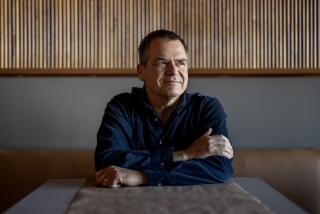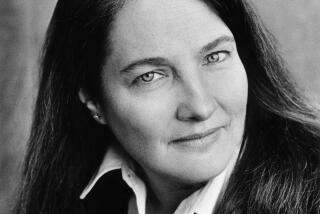Writer Packs Surprises in ‘Hemingway’s Suitcase’
- Share via
In the winter of 1922, newspaper correspondent and budding author Ernest Hemingway left his wife, Hadley, in Paris to cover an international conference in Lausanne, Switzerland. The plan was for Hadley to join Hemingway in Lausanne and go on a skiing trip with him.
As a surprise for her husband before leaving Paris, Hadley gathered up everything that Hemingway had written up to that time--20 or more Nick Adams stories, an unfinished novel and some sketches--so he could work on them in the evenings. She carefully packed it all into a small suitcase.
But before her train departed Paris, Hadley discovered that the suitcase with the manuscripts--everything, including Hemingway’s longhand originals, the typescripts and carbon copies--was missing. Vanished.
“No amount of sleuthing ever brought the valise to light,” the former Mrs. Hemingway is reported as saying in 1952, “and so deeply had Ernest put himself into this writing that I think he never recovered from the pain of this irreparable loss.”
The missing cache of early Hemingway material has fascinated scholars and Hemingway buffs for decades.
But suppose the suitcase still existed?
Suppose 68 years after it disappeared, an American bibliophile traveling in Europe came into possession of the legendary suitcase with its valuable contents still inside?
And suppose that same person decided to publish what appear to be genuine Hemingway short stories? But to avoid infringing on the rights of the Hemingway Estate, he hatches a scheme to publish the stories without making any claim as to who wrote them.
Critics would know about the missing suitcase without it even being mentioned. Whether the stories are authentic or not, they would read like Hemingway. And given the controversy that would surely ensue, it would be a guaranteed bestseller.
That’s the premise of MacDonald Harris’s aptly titled literary novel, “Hemingway’s Suitcase” (Simon & Schuster), a psychological mystery in which the famous missing suitcase comes into the hands of dilettante Los Angeles writer Nils-Frederik Glas. Or so it seems.
The manipulative Glas enlists his son Alan, a second-rate Los Angeles literary agent, and his antiquarian book-dealer friend, Wolf, to help him pull off what may be the biggest literary hoax of all time.
Harris wastes no time in serving up one of the novel’s unique delights, the first of five complete “Nick Adams” stories that appear during the course of the narrative.
“Hemingway’s Suitcase” opens thusly:
There was a crowd at the Rotonde but they found a table inside looking out through the windows at the terrasse and the boulevard. It was five o’clock and already dark. It was cold outside but inside it was warm and the windows were steamy. Nick saw Helen looking around at the pictures. . . .
As the Newport Beach author sees it, the success or failure of “Hemingway’s Suitcase” hinges on his five “Hemingway” short stories.
“I knew from the first time I thought of this idea that it was a beautiful concept,” Harris said. “But what I didn’t know is whether I could carry out this concept, whether the execution would be any good.”
Judging by several early reviews he seems to have pulled it off. A review in the Chicago Tribune praises the “wit and brilliance” of Harris’ novel. And, says a favorable review in the Washington Post: “MacDonald Harris does the next best thing to finding the lost stories.”
MacDonald Harris is the pen name for Donald Heiney, one of the founders of the acclaimed MFA Program in Writing at UC Irvine, where he teaches the graduate fiction-writing workshop. The author, who sold his first short story in 1947 to Esquire, has written 13 novels, including “The Balloonist,” which was nominated for the National Book Award.
Harris has known about the famous Hemingway suitcase since 1964 when he read “A Moveable Feast,” Hemingway’s posthumously published collection of stories about his early years in Paris. His interest was restimulated when he learned more details about the missing suitcase in Kenneth S. Lynn’s 1987 Hemingway biography.
“Ever since I heard about this suitcase story it’s intrigued me,” Harris said. “I thought, ‘I’m going to write about that some day.’ But I wanted to wait until the idea was ripe, until I felt I could handle it and (knew) just what I wanted to do with it.”
A conversation with Laguna Beach science fiction author Gregory Benford, in which the two authors speculated about what someone could do if he found Hemingway’s suitcase today, provided the impetus for Harris to begin writing three years ago.
One early idea he considered was to simply write a book much as Nils-Frederik Glas presents it: Writing 20 imitation Hemingway stories and publishing them under the title “Hemingway’s Suitcase: Stories Edited by MacDonald Harris.”
“Now that might have been a highly interesting book,” muses Harris. “The trouble is that it’s also on the dubious side of ethics, and I don’t think either my agent or any editor would really go for that.”
Before he began writing, Harris reread all of Hemingway’s novels and short stories. He also reread the standard biographies and critical studies of the author.
In writing the short stories for his novel, Harris was well aware he was walking a fine line.
“I did not write the stories with one finger in Hemingway’s stories. That would have resulted in parody, I think,” said Harris, who was never tempted to enter the annual imitation Hemingway contest sponsored by Harry’s Bar and American Grill.
“It’s pretty easy to imitate Hemingway. For example, these things like the repetition of words over and over again, or what I call and splices-- the long, winding sentences connected with ands .
“What I did was to read everything that Hemingway had written, with care and attention, and then forget it. Six months later, with my memories of Hemingway--the echoes of Hemingway--then I wrote.”
The result, Harris said, is a kind of collision between Hemingway’s style and Harris’ own instincts as a writer.
“I can tell you ways in which these stories are not authentic Hemingway,” he said. “I think a real expert could look at them and say there is something wrong here.”
Harris said his stories in the novel are more highly plotted than Hemingway’s and they “reflect my own value system as much as they do Hemingway’s.”
Harris, who doesn’t share Hemingway’s fascination with violence and criticizes “the crude way” the Bearded One generally portrayed women in his fiction, added that “Hemingway is very interested in place, mood, tone and dialogue. But I’m interested in story, too.”
As for his approach to the task at hand, he said, “I tried simply to write the best stories I could.”
After finishing a first draft of the novel last summer, Harris and his wife, Ann, made one of their periodic visits to Paris where Harris visited Papa’s old haunts, taking notes and photographs as he went.
When Harris returned home and began making revisions, he read Hemingway’s fiction again, “just to be sure I had it right.”
Because the five stories are capturing most of the attention, Harris doesn’t think people will realize the effort he put into what he calls the novel’s frame story about the eccentric Nils-Frederik and his family.
The novel’s short stories are lighter and more ironic, Harris said, while “the frame part of the story is deeper and more complex.”
And despite favorable early reviews and warm receptions of his work during readings he has done at Dutton’s in Brentwood and Rizzoli International Bookstore in Costa Mesa, Harris is still not sure he has successfully pulled off the difficult task of creating believable “Hemingway.”
“I know I’ve got a beautiful idea for a novel,” he said. “As soon as anyone sees the title, or they hear what the book is about, (they say), ‘Wow I want to read that!’ ”
But the question is, he said, whether the novel will stand the test of a careful reading. And it all hinges on those five stories.
“That’s what’s remarkable about the book and also where it’s vulnerable,” Harris said. “Any critic who wants can say, ‘Well, he didn’t carry it off. It doesn’t sound like Hemingway to me.’ ”
Later that month Nick and George went to shoot grouse on the Marne. It was a thing they had planned for some time. It was swell country for shooting in the Marais de Saint-Gond and Nick had been there before. . . .
More to Read
Sign up for our Book Club newsletter
Get the latest news, events and more from the Los Angeles Times Book Club, and help us get L.A. reading and talking.
You may occasionally receive promotional content from the Los Angeles Times.









